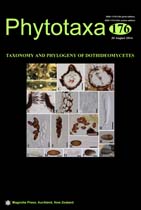Abstract
A new species, Microthyrium propagulensis, collected in Yunnan Province, southwestern China is introduced. The species is typical of Microthyriaceae (Microthyriales) in having superficial thyriothecia with a poorly developed basal layer and a prominent darker central ostiole, bitunicate asci and 1-septate ascospores. It is similar to the generic type, M. microscopicum, but differs in having relatively small ascospores, with two apical cilia, which lie downloads from the ascospore apex at a 45° angle. Phylogenetic analysis based on combined LSU and SSU gene sequence data clearly place this species in Microthyrium, but distinguishes it from Microthyrium microscopicum. This second sequence from a Microthyrium species indicates that the putative sequence of the type of this genus is CBS has been correctly named and supports the distinctiveness of Microthyriales and Microthyriaceae.

